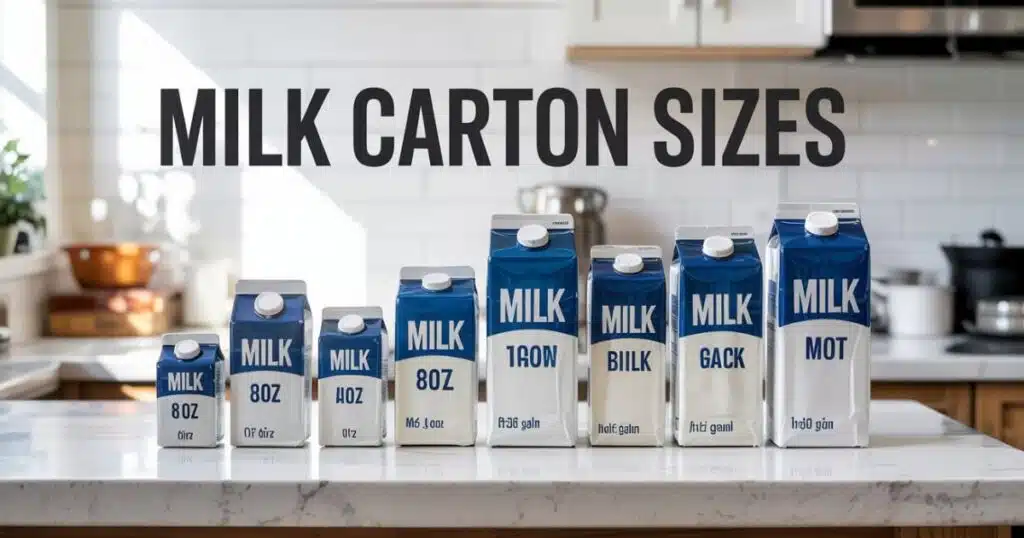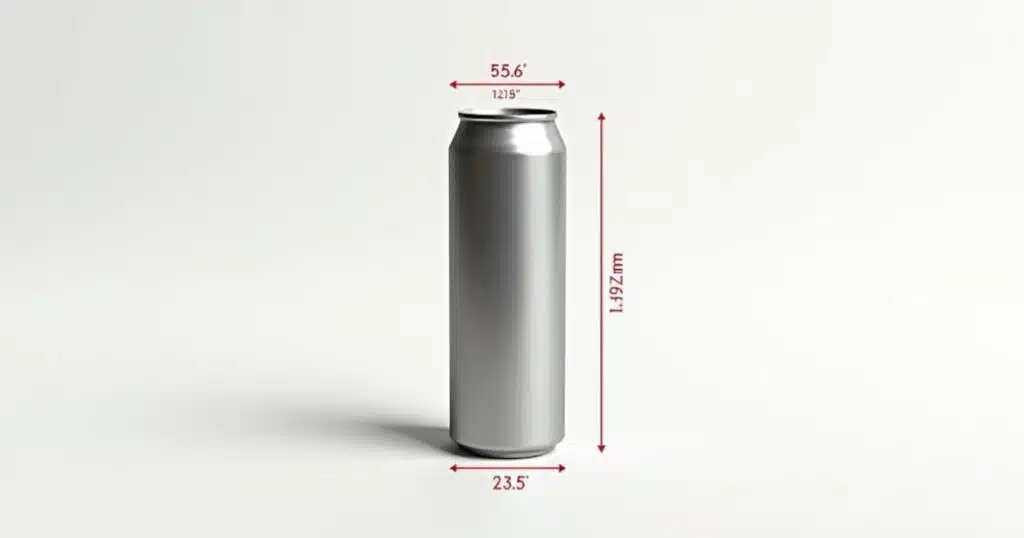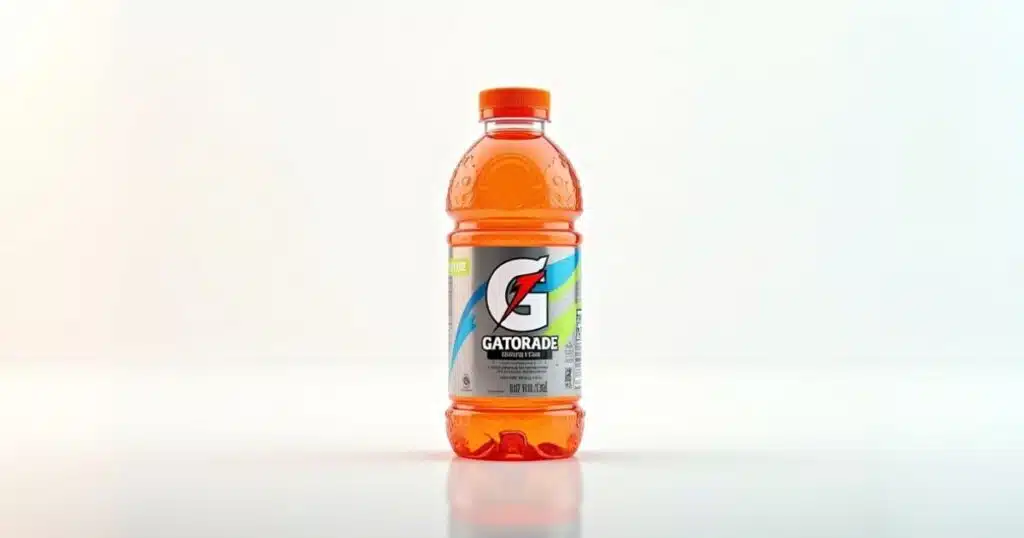Remember the last time you stood in the dairy aisle, staring at the wall of milk cartons? From tiny single-serving containers to massive gallon jugs, milk packaging comes in a dizzying array of shapes and sizes. What started as simple glass bottles has evolved into a sophisticated system of containers designed for efficiency, preservation, and consumer convenience.
The humble milk carton might seem straightforward, but there’s a fascinating world of design, history, and practical considerations behind these everyday containers.
Whether you’re a parent stocking up for hungry kids, a baker needing precise measurements, or just curious about why milk comes in the containers it does, understanding milk carton sizes can actually make your shopping trips more efficient and reduce waste in your household.
How Big Are Standard Milk Cartons?
Milk cartons vary dramatically in size, ranging from tiny 8-ounce school lunch boxes to gallon containers that can weigh over 8 pounds when full. Most households are familiar with the standard quart (32 oz), half-gallon (64 oz), and gallon (128 oz) sizes that dominate refrigerator shelves across America. T
hese dimensions didn’t happen by accident they evolved through decades of dairy industry innovation, consumer preferences, and practical considerations for storage and transportation.
The Evolution of Milk Packaging
The story of milk cartons begins long before the modern supermarket. For centuries, milk moved from farm to table in metal pails, with customers bringing their own containers for filling. This system worked fine when most people lived near dairy farms, but as urban populations grew and food safety standards developed, better solutions became necessary.
From Glass Bottles to Paper Cartons
Before cardboard and plastic took over, glass bottles dominated milk delivery. These heavy, reusable containers were collected and returned through an elaborate system of home delivery. The milkman wasn’t just a nostalgic figure he was essential infrastructure!
“The glass milk bottle represented a revolution in food safety,” explains dairy historian Margaret Jenkins. “Before sealed containers, milk was ladled from open containers, exposing it to all sorts of contaminants.”
The transition to paper cartons began in the 1930s when inventor John Van Wormer patented the paper milk container. His invention named the “Pure-Pak” could be formed, sterilized, filled, and sealed at the dairy, dramatically reducing contamination risk. The lightweight design also cut shipping costs compared to heavy glass bottles.
Today’s milk carton designs still reflect this innovative heritage, though materials and technology have evolved considerably.
Common Milk Carton Sizes and Their Uses
School Milk Cartons (8 oz / 236 ml)
Those tiny milk cartons from school lunch hold exactly 8 ounces (about 236 milliliters) of milk. They’re specifically designed for children’s nutritional needs and portion control in institutional settings.
These rectangular containers stand about 3.75 inches tall and measure roughly 2.25 inches on each side. The familiar gable-top design (that distinctive peaked roof shape) makes them instantly recognizable and sometimes frustratingly difficult for small hands to open!
School milk cartons represent a perfect example of design meeting specific needs. Their size provides exactly the recommended serving of dairy for children while minimizing waste in institutional settings. The compact footprint also allows cafeterias to store and distribute them efficiently.
Did you know these mini-cartons also serve as an educational tool? Many school districts print educational facts, puzzles, or nutrition information right on the cartons, turning them into learning opportunities while students drink.
Pint Cartons (16 oz / 473 ml)
Pint-sized milk cartons hold 16 ounces (about 473 milliliters) and typically stand about 5-6 inches tall. They’re perfect for small households, recipes requiring specific amounts, or specialty dairy products like cream or buttermilk.
Bakers particularly appreciate pint containers because many recipes call for precisely this amount. Coffee shops also frequently stock milk in pint containers for efficiency the size allows baristas to quickly refill pitchers without opening larger containers that might spoil before being used.
The pint size hits a sweet spot in dairy packaging large enough to be economical but small enough to ensure freshness for individuals or couples who don’t use milk quickly.
Interestingly, while pint milk cartons are common in some regions, other areas rarely see them in stores. Regional dairy production capabilities and local consumer preferences largely determine which sizes dominate in different markets.
Quart Cartons (32 oz / 946 ml)
Quart milk cartons contain 32 ounces (approximately 946 milliliters) and typically stand about 7-8 inches tall with a footprint of roughly 4 inches square. This mid-sized option bridges the gap between small single-serving containers and bulk family purchases.
The quart size gained popularity during the post-war period when refrigerators became common household appliances. Their dimensions were specifically designed to fit efficiently on refrigerator door shelves a design consideration that continues to influence dairy packaging today.
Quart containers make perfect sense for small families, occasional milk drinkers, or specialized dairy products like chocolate milk or lactose-free varieties that might be consumed more slowly than regular milk.
A fascinating historical note: during World War II, quart-sized milk cartons became particularly important as the metal used for milk cans was diverted to military production. The paper carton’s conservation of strategic materials made it patriotic as well as practical!
Half-Gallon Cartons (64 oz / 1.89 L)
Half-gallon milk containers hold 64 ounces (about 1.89 liters) and represent one of the most common sizes purchased by American families. These cartons typically stand 9-10 inches tall and have become a standard unit for dairy merchandising.
The half-gallon size strikes an excellent balance between economy and practicality. It’s large enough to be economical for families but not so large that the milk spoils before being consumed. Their dimensions also fit perfectly in most refrigerator door shelves a design synergy that wasn’t accidental.
Dairy industry engineer Thomas Wilson explains: “Much of modern refrigerator design evolved alongside milk packaging. The refrigerator door shelf and the half-gallon carton developed together in a kind of dimensional symbiosis.”
While traditional paper cartons still dominate this size category, plastic jugs with handles have gained significant market share, especially in regions where shoppers travel longer distances from store to home. The added durability and convenient grip make them preferred by many consumers despite environmental concerns about plastic.
See Also: Chip Bag Sizes – Sizes of Common Objects and Stuff
Gallon Containers (128 oz / 3.78 L)
The gallon milk jug contains 128 ounces (approximately 3.78 liters) and represents the most economical purchase option for large families or institutions. These substantial containers typically stand 10-12 inches tall and require considerable refrigerator space.
While paper cartons were once common in this size, plastic gallons have become the industry standard due to their durability, lighter weight, and integrated handle for easier pouring. Their distinctive shape with the handle formed as part of the molded plastic rather than added separately represents a triumph of functional design.
Gallon containers dramatically reduce packaging-to-product ratios, making them environmentally efficient in terms of materials used per ounce of milk. However, this advantage only applies if all the milk gets consumed before spoiling.
Did you know the average gallon of milk weighs about 8.6 pounds when full? This substantial weight influenced the evolution of the distinctive handle design we now take for granted. Early plastic gallon containers lacked integrated handles, making them notoriously difficult to pour without spilling.
Regional and International Variations
Milk carton sizes vary significantly around the world, reflecting different measurement systems, consumption patterns, and distribution networks.
European Milk Packaging
In Europe, milk typically comes in 1-liter (33.8 oz) or 2-liter (67.6 oz) containers, conforming to the metric system. These sizes don’t precisely match American quarts and half-gallons, creating subtle differences in recipes when cooking across cultural boundaries.
European milk packaging also tends to favor different designs, with shelf-stable UHT (ultra-high temperature) milk often sold in aseptic brick-shaped cartons that don’t require refrigeration until opening. This packaging innovation reflects different shopping patterns and smaller refrigerators in many European households.
Asian Milk Packaging Innovations
In Japan and parts of Asia, milk frequently comes in distinctive plastic pouches or specialized bottles designed for smaller refrigerators and households. Single-serving sizes dominate in regions where daily shopping trips are common and storage space is limited.
South Korea has pioneered innovative banana-shaped milk containers that prevent stacking, ensuring each container gets consumed quickly rather than lingering forgotten at the back of the refrigerator a clever design solution to reduce waste.
The Science Behind Milk Carton Design
Modern milk cartons represent decades of engineering refinement focused on preservation, transportation efficiency, and consumer convenience. Every aspect from the microscopic polyethylene coating that prevents leakage to the precise angle of gable-top folds serves a specific purpose.
Materials Science
Today’s typical milk carton consists of several layers of paperboard coated with food-grade polyethylene. This combination provides structural integrity while creating an oxygen and light barrier that preserves milk freshness.
“The seemingly simple milk carton is actually a marvel of materials engineering,” notes packaging scientist Dr. Ellen Rodriguez. “The paperboard provides structural support while being lightweight and biodegradable, and the polyethylene layer creates the necessary moisture barrier without affecting taste.”
For ultra-pasteurized products with extended shelf life, even more sophisticated packaging may include aluminum foil layers that provide absolute light and oxygen barriers, extending unrefrigerated shelf life to months rather than days.
Ergonomics and User Experience
The ridge along the top edge of plastic milk jugs isn’t just decorative it provides structural reinforcement while creating a clean pouring stream. Similarly, the distinctive “roof” shape of traditional cartons creates a natural spout when opened correctly.
These design elements emerged through decades of consumer testing and refinement. Early milk cartons were notoriously difficult to open evenly, leading to the development of specialized opening mechanisms like perforated pull-tabs and plastic screw caps on gable-top cartons.
See Also: Gatorade Bottle Dimensions – Sizes of Common Objects and Stuff
Environmental Considerations
Milk packaging has significant environmental impacts, with different sizes and materials presenting different sustainability challenges and advantages.
Traditional paper cartons are largely recyclable and contain substantial renewable materials, though the polyethylene coating complicates recycling in some facilities. Plastic milk jugs are highly recyclable in theory, but actual recycling rates remain disappointingly low in many regions.
The environmental equation becomes even more complex when considering transportation efficiency (larger containers generally have better product-to-packaging ratios) versus food waste (smaller containers may result in less discarded milk).
Some innovative dairies have begun exploring alternative packaging, including returnable glass bottles harkening back to earlier delivery systems, compostable bioplastics, and concentrated milk products that reduce shipping weight and volume.
Practical Applications of Understanding Milk Carton Sizes
Kitchen Conversion Tips
Understanding standard milk carton volumes can simplify cooking and baking. For instance:
- A school milk carton (8 oz) equals exactly 1 cup in recipes
- A quart container holds precisely 4 cups
- A half-gallon provides 8 cups enough for most family-sized recipes
These standardized measurements make milk cartons useful reference points even when measuring other ingredients.
Storage Optimization
Different milk carton designs utilize refrigerator space differently. Rectangular cartons maximize shelf space efficiency but may be harder to pour from when nearly full. Round plastic jugs pour more easily but leave wasted space between containers.
For optimal refrigerator organization:
- Door shelves typically accommodate quart and half-gallon cartons perfectly
- Gallon jugs usually require main compartment storage
- Consider transferring milk to smaller containers as it’s consumed to reclaim space
Budget Considerations
Larger milk containers almost always offer better value per ounce, but this economy only matters if you actually consume all the milk before it spoils. For households with variable milk consumption, having both a larger container for regular use and a smaller ultra-pasteurized backup container can provide both economy and convenience.
Future Trends in Milk Packaging
The milk carton continues to evolve with changing consumer preferences, technological advancements, and environmental concerns.
Emerging trends include:
- Smart packaging with QR codes linking to source farms and production information
- Time-temperature indicators that show whether milk has been properly refrigerated
- Concentrated milk products that reduce shipping weight and packaging
- Plant-based milk containers made from agricultural waste or mushroom-based materials
- Return to delivered milk in reusable containers through subscription services
Conclusion
Far from being trivial, milk carton sizes reflect a fascinating intersection of science, consumer behavior, economics, and environmental concerns. The containers we take for granted represent centuries of innovation in food preservation and distribution.
Understanding these different sizes helps you make smarter purchasing decisions based on your household’s actual consumption patterns reducing both food waste and grocery bills while ensuring you always have the right amount on hand for your needs.
Next time you’re in the dairy aisle, take a moment to appreciate the humble milk carton a perfect example of how thoughtful design shapes our everyday experiences in ways we rarely notice but constantly rely upon.
Look around your kitchen how many products have packaging influenced by milk carton innovations? From juice boxes to soup containers, the legacy of milk packaging design extends far beyond the dairy case!
Read more knowledgeable blogs on Measure Take.



